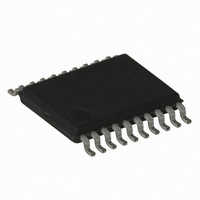ATTINY167-15XD Atmel, ATTINY167-15XD Datasheet - Page 156

ATTINY167-15XD
Manufacturer Part Number
ATTINY167-15XD
Description
MCU AVR 16K FLASH 15MHZ 20-TSSOP
Manufacturer
Atmel
Series
AVR® ATtinyr
Datasheet
1.ATTINY167-15MD.pdf
(283 pages)
Specifications of ATTINY167-15XD
Core Processor
AVR
Core Size
8-Bit
Speed
16MHz
Connectivity
I²C, LIN, SPI, UART/USART, USI
Peripherals
Brown-out Detect/Reset, POR, PWM, Temp Sensor, WDT
Number Of I /o
16
Program Memory Size
16KB (8K x 16)
Program Memory Type
FLASH
Eeprom Size
512 x 8
Ram Size
512 x 8
Voltage - Supply (vcc/vdd)
2.7 V ~ 5.5 V
Data Converters
A/D 11x10b
Oscillator Type
Internal
Operating Temperature
-40°C ~ 150°C
Package / Case
20-TSSOP
Processor Series
ATTINY1x
Core
AVR8
Data Bus Width
8 bit
Data Ram Size
512 B
Maximum Clock Frequency
16 MHz
Maximum Operating Temperature
+ 85 C
Mounting Style
SMD/SMT
3rd Party Development Tools
EWAVR, EWAVR-BL
Development Tools By Supplier
ATAVRDRAGON, ATSTK500, ATSTK600, ATAVRISP2, ATAVRONEKIT
Minimum Operating Temperature
- 40 C
For Use With
ATSTK600-SOIC - STK600 SOCKET/ADAPTER FOR SOIC
Lead Free Status / RoHS Status
Lead free / RoHS Compliant
- Current page: 156 of 283
- Download datasheet (5Mb)
14.4
14.4.1
14.4.2
14.4.3
14.4.4
14.4.5
14.5
14.5.1
156
Alternative USI Usage
Register Descriptions
ATtiny87/ATtiny167
Half-duplex Asynchronous Data Transfer
4-bit Counter
12-bit Timer/Counter
Edge Triggered External Interrupt
Software Interrupt
USIDR – USI Data Register
When the USI unit is not used for serial communication, it can be set up to do alternative tasks
due to its flexible design.
By utilizing the USI Data Register in Three-wire mode, it is possible to implement a more com-
pact and higher performance UART than by software only.
The 4-bit counter can be used as a stand-alone counter with overflow interrupt. Note that if the
counter is clocked externally, both clock edges will generate an increment.
Combining the USI 4-bit counter and Timer/Counter0 allows them to be used as a 12-bit
counter.
By setting the counter to maximum value (F) it can function as an additional external interrupt.
The Overflow Flag and Interrupt Enable bit are then used for the external interrupt. This fea-
ture is selected by the USICS1 bit.
The counter overflow interrupt can be used as a software interrupt triggered by a clock strobe.
• Bits 7:0 – USID7..0: USI Data
When accessing the USI Data Register (USIDR) the Serial Register can be accessed directly.
If a serial clock occurs at the same cycle the register is written, the register will contain the
value written and no shift is performed. A (left) shift operation is performed depending of the
USICS1..0 bits setting. The shift operation can be controlled by an external clock edge, by a
Timer/Counter0 Compare Match, or directly by software using the USICLK strobe bit. Note
that even when no wire mode is selected (USIWM1..0 = 0) both the external data input
(DI/SDA) and the external clock input (USCK/SCL) can still be used by the USI Data Register.
The output pin in use, DO or SDA depending on the wire mode, is connected via the output
latch to the most significant bit (bit 7) of the Data Register. The output latch is open (transpar-
ent) during the first half of a serial clock cycle when an external clock source is selected
(USICS1 = 1), and constantly open when an internal clock source is used (USICS1 = 0). The
output will be changed immediately when a new MSB written as long as the latch is open. The
latch ensures that data input is sampled and data output is changed on opposite clock edges.
Bit
Read/Write
Initial Value
USID7
R/W
7
0
USID6
R/W
6
0
USID5
R/W
5
0
USID4
R/W
4
0
USID3
R/W
3
0
USID2
R/W
2
0
USID1
R/W
1
0
USID0
R/W
7728G–AVR–06/10
0
0
USIDR
Related parts for ATTINY167-15XD
Image
Part Number
Description
Manufacturer
Datasheet
Request
R

Part Number:
Description:
Manufacturer:
Atmel Corporation
Datasheet:

Part Number:
Description:
Manufacturer:
Atmel Corporation
Datasheet:

Part Number:
Description:
MCU AVR 16K FLASH 15MHZ 32-QFN
Manufacturer:
Atmel
Datasheet:

Part Number:
Description:
IC MCU AVR 16K FLASH 20TSSOP
Manufacturer:
Atmel
Datasheet:

Part Number:
Description:
MCU AVR 16K FLASH 15MHZ 32-QFN
Manufacturer:
Atmel
Datasheet:

Part Number:
Description:
MCU AVR 16K FLASH 15MHZ 20-SOIC
Manufacturer:
Atmel
Datasheet:

Part Number:
Description:
MCU AVR 16K FLASH 15MHZ 20-TSSOP
Manufacturer:
Atmel
Datasheet:

Part Number:
Description:
IC MCU AVR 16K FLASH 20SOIC
Manufacturer:
Atmel
Datasheet:










